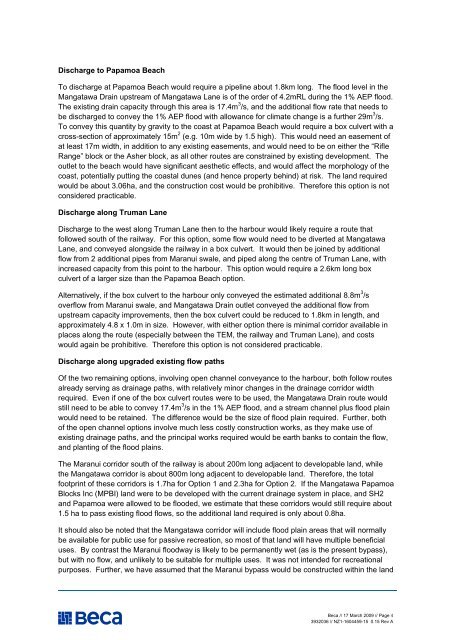2. Mangatawa catchment consents for earthworks, storm water ...
2. Mangatawa catchment consents for earthworks, storm water ...
2. Mangatawa catchment consents for earthworks, storm water ...
- No tags were found...
Create successful ePaper yourself
Turn your PDF publications into a flip-book with our unique Google optimized e-Paper software.
Discharge to Papamoa Beach<br />
To discharge at Papamoa Beach would require a pipeline about 1.8km long. The flood level in the<br />
<strong>Mangatawa</strong> Drain upstream of <strong>Mangatawa</strong> Lane is of the order of 4.2mRL during the 1% AEP flood.<br />
The existing drain capacity through this area is 17.4m 3 /s, and the additional flow rate that needs to<br />
be discharged to convey the 1% AEP flood with allowance <strong>for</strong> climate change is a further 29m 3 /s.<br />
To convey this quantity by gravity to the coast at Papamoa Beach would require a box culvert with a<br />
cross-section of approximately 15m 2 (e.g. 10m wide by 1.5 high). This would need an easement of<br />
at least 17m width, in addition to any existing easements, and would need to be on either the “Rifle<br />
Range” block or the Asher block, as all other routes are constrained by existing development. The<br />
outlet to the beach would have significant aesthetic effects, and would affect the morphology of the<br />
coast, potentially putting the coastal dunes (and hence property behind) at risk. The land required<br />
would be about 3.06ha, and the construction cost would be prohibitive. There<strong>for</strong>e this option is not<br />
considered practicable.<br />
Discharge along Truman Lane<br />
Discharge to the west along Truman Lane then to the harbour would likely require a route that<br />
followed south of the railway. For this option, some flow would need to be diverted at <strong>Mangatawa</strong><br />
Lane, and conveyed alongside the railway in a box culvert. It would then be joined by additional<br />
flow from 2 additional pipes from Maranui swale, and piped along the centre of Truman Lane, with<br />
increased capacity from this point to the harbour. This option would require a <strong>2.</strong>6km long box<br />
culvert of a larger size than the Papamoa Beach option.<br />
Alternatively, if the box culvert to the harbour only conveyed the estimated additional 8.8m 3 /s<br />
overflow from Maranui swale, and <strong>Mangatawa</strong> Drain outlet conveyed the additional flow from<br />
upstream capacity improvements, then the box culvert could be reduced to 1.8km in length, and<br />
approximately 4.8 x 1.0m in size. However, with either option there is minimal corridor available in<br />
places along the route (especially between the TEM, the railway and Truman Lane), and costs<br />
would again be prohibitive. There<strong>for</strong>e this option is not considered practicable.<br />
Discharge along upgraded existing flow paths<br />
Of the two remaining options, involving open channel conveyance to the harbour, both follow routes<br />
already serving as drainage paths, with relatively minor changes in the drainage corridor width<br />
required. Even if one of the box culvert routes were to be used, the <strong>Mangatawa</strong> Drain route would<br />
still need to be able to convey 17.4m 3 /s in the 1% AEP flood, and a stream channel plus flood plain<br />
would need to be retained. The difference would be the size of flood plain required. Further, both<br />
of the open channel options involve much less costly construction works, as they make use of<br />
existing drainage paths, and the principal works required would be earth banks to contain the flow,<br />
and planting of the flood plains.<br />
The Maranui corridor south of the railway is about 200m long adjacent to developable land, while<br />
the <strong>Mangatawa</strong> corridor is about 800m long adjacent to developable land. There<strong>for</strong>e, the total<br />
footprint of these corridors is 1.7ha <strong>for</strong> Option 1 and <strong>2.</strong>3ha <strong>for</strong> Option <strong>2.</strong> If the <strong>Mangatawa</strong> Papamoa<br />
Blocks Inc (MPBI) land were to be developed with the current drainage system in place, and SH2<br />
and Papamoa were allowed to be flooded, we estimate that these corridors would still require about<br />
1.5 ha to pass existing flood flows, so the additional land required is only about 0.8ha.<br />
It should also be noted that the <strong>Mangatawa</strong> corridor will include flood plain areas that will normally<br />
be available <strong>for</strong> public use <strong>for</strong> passive recreation, so most of that land will have multiple beneficial<br />
uses. By contrast the Maranui floodway is likely to be permanently wet (as is the present bypass),<br />
but with no flow, and unlikely to be suitable <strong>for</strong> multiple uses. It was not intended <strong>for</strong> recreational<br />
purposes. Further, we have assumed that the Maranui bypass would be constructed within the land<br />
Beca // 17 March 2009 // Page 4<br />
3932036 // NZ1-1604459-15 0.15 Rev A
















